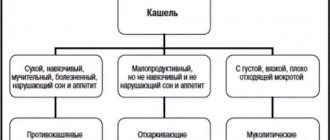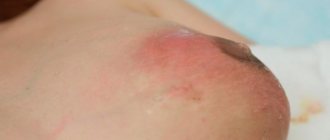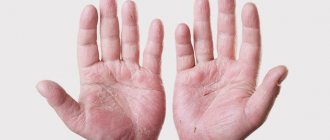Any, even the slightest deterioration in the child’s well-being causes anxiety and concern among parents. A cough is common, which intensifies at night and subsides during the day. To quickly stop a child’s night cough, it is necessary to correctly determine its cause. Various factors provoke this condition. Each situation requires individual treatment methods. In the most severe cases, a doctor's consultation is necessary.
There can be many reasons for a child coughing at night, so there is no point in starting to treat a symptom without determining its origin.
How to help a child
You can also help your child at home if a cough attack is caused by allergies, bronchitis or laryngitis. According to Dr. Komarovsky, first of all, optimal conditions in the home should be created. We are talking about normalizing temperature and humidity.
Hydration
The air humidity at home should be about 55%. But you need to ensure that this figure does not exceed 70%. It is because of the dry, stale air that children often begin to cough. This phenomenon is often observed in winter when the heating system is operating.
To humidify the air, just use a special household humidifier or hang wet towels over the heating radiators. Even if coughing is caused by other reasons, this will help to quickly relieve a severe coughing attack in a child. When the mucous membrane is moistened, pathogenic microorganisms stop actively multiplying and irritating the pharynx.
Temperature
The air temperature in the home should not exceed 22 degrees. The air must be constantly renewed; for this, in the warm season the window is kept constantly open, and in winter the home is simply ventilated more often.
If you have air conditioning in your home, don't forget to humidify the air. The child should not be in a draft or under a stream of air from an air conditioner.
Water treatments
Water treatments will help calm a debilitating cough. If a sick baby does not have a fever, then before going to bed he is bathed in a bathtub filled with water at a comfortable temperature. Water procedures help soften the mucous membrane of the nasopharynx and dilute sputum.
You should bathe your baby for at least 20 minutes. The bathroom door should be left slightly open to allow fresh air to enter.
You can add decoctions of medicinal herbs to the water. To do this, brew thyme, chamomile, sage or eucalyptus. You can pour a few tablespoons of the drug Rotokan. For children over 5 years old, you can add a little essential oil to the water. Oils from coniferous trees, citrus fruits and tea tree are suitable.
Drink plenty of fluids
Drinking plenty of fluids will also help stop a coughing attack. A sick baby is offered warm tea, jelly or fruit drink. If the baby coughs at night, he should be woken up and given hot tea with raspberries or black currants. Usually, such a simple action helps to quickly stop a coughing attack.
Traditional therapy
Monitoring attacks of dry cough in a young patient requires the use of peripheral and central drugs. These medications allow you to activate the cough center located in the medulla oblongata and quickly remove accumulated mucus from the body.
It is not recommended to prescribe antitussive drugs to children under two years of age. In this case, the use of herbal syrups (commercial medicines or products manufactured in a pharmacy) is prescribed. These drugs are effective in treating mild forms of cough. In other cases, it is necessary to use more effective medications. Syrups based on natural ingredients can cause an allergic reaction in a child, and therefore it is necessary to select drugs based on the patient’s tolerance to a particular component.
Drugs used to relieve a coughing attack are divided into the following categories:
- mucolytics - prescribed if the cough is dry and sputum thinning is required;
- reflex drugs designed to activate the cough center of the brain and ensure the removal of sputum;
- sedatives used after removing phlegm from the body to reduce the activity of the cough center.
How to stop a coughing attack using folk remedies
When answering the question of how to stop an attack of wet cough in a child, it is important to note the importance of traditional medicine methods. Popular among non-traditional remedies are compresses based on boiled potatoes, honey, vegetable oil or cottage cheese, mustard plasters, and rubbing the chest with black radish juice.
The following oral medications have a good effect:
- infusion of figs with warm milk;
- infusion of chopped aloe leaves, honey and butter;
- infusion of sage leaves and hot milk;
- infusion of black radish juice and a small amount of honey (sugar);
- decoction of onions, honey and sugar;
- mashed warmed bananas with sugar;
- fresh cabbage juice with honey;
- infusion of plantain leaves;
- decoction of thyme leaves;
- lemon juice with glycerin and honey;
- warm milk with butter;
- syrup from fresh onion juice with sugar.
Any healthy hot drink will help with a suffocating cough: tea with chamomile, milk with butter and honey, or milk with a pinch of soda. You should drink in small sips. This will soften the larynx, calm the cough, and the baby will be able to fall asleep.
Black radish juice can also relieve a cough. To do this, cut out the center of the radish and add a spoonful of honey or sugar inside. In this form, the radish should be left for 10-12 hours, lowered into a container with water. During this time, a sweet medicinal syrup is formed in the middle of the root vegetable, which should be taken 1 teaspoon before bed. You can rub your baby’s back and chest with black radish juice overnight; after such rubbing he will fall asleep peacefully.
Boil 1 tbsp milk in 1 glass. spoon of sage herb. Leave the product in a warm place for about half an hour and strain. Give your child 1 glass of hot broth before bedtime. The baby will quickly fall asleep without coughing attacks.
Elimination of cough in various diseases
The symptoms of each respiratory disease make it possible to decide how to stop one or another type of coughing attack. With whooping cough, they increase due to irritation of a special center in the brain by the bacterium. The cause of cough is solely a disruption of the nervous system. In this case, the main thing is not the elimination, but the prevention of the attack. It is necessary to provide the patient with peace, protect him from sudden loud sounds, bright light and other irritants. This coughing attack cannot be stopped with the help of classical medications and folk remedies. It is necessary to ensure that the baby takes sedatives.
Coughing attacks with false croup are associated with narrowing of the child's upper respiratory tract, which requires emergency hospitalization. At the same time, the disease is characterized by swelling of the laryngeal mucosa and viscosity of sputum. In order to prevent this condition, it is recommended at the initial stage of the pathology to give the patient plenty of warm decoctions and ventilate his room more often. To eliminate the attack, it is necessary to ensure that the child takes large doses of mucolytic drugs. To reduce its intensity, it is recommended to pour hot water into a basin or bathtub and allow the patient to breathe warm, moist air.
Tracheitis is characterized by the occurrence of attacks of dry cough at the initial stage. To prevent the disease from progressing to a severe form, it is necessary to ensure that the baby takes mucolytic drugs that increase sputum production. If a wet cough appears, it is necessary to stop taking medications and begin giving the sick child chest massage. At the same time, you need to provide him with plenty of warm drinks, rich in vitamins: fruit drinks, freshly squeezed juices, herbal infusions. If there is no fever, it is recommended to give the baby hot foot baths and rubbing. This will increase blood flow to the inflamed area and actively remove toxins from the body.
Similar to false croup, obstructive bronchitis is distinguished by the viscosity of sputum. The body cannot remove it on its own, which is why the child’s bronchi undergo spasm and he experiences difficulty breathing. In this case, it is necessary to treat with mucolytic drugs and, after thinning the sputum, with expectorants. Drug therapy is carried out simultaneously with plenty of warm drinks and massages. Massaging the chest should be carried out 15-20 minutes after taking medications by lightly stroking and tapping with your fingertips. Massage is required in cases where the child is intolerant to medications.
If you notice a lingering cough in your child that cannot be treated with traditional and folk methods, you should consult a doctor. Often a severe cough in a child is associated with the constant unsatisfactory condition of the laryngeal mucosa caused by a chronic disease or allergy. In this case, the child’s body constantly produces a huge amount of mucus, which must be coughed up. Parents themselves, giving their children various cough syrups, provoke a long course of this symptom. It is necessary to stop using them, providing the child with plenty of fluids and massage in return.
How to relieve a child's cough
If the reason is already known, you should try to facilitate the coughing process by all possible means, because this greatly weakens the child. The doctor is guaranteed to advise you not only on how to treat the disease, but also how to relieve an attack of dry cough. But these don’t necessarily have to be pills and pharmaceutical drugs.
Among the most effective cough remedies are:
- warm drink;
- black radish;
- honey;
- massage;
- essential oils.
Warm alkaline drinking improves the process of mucus separation. Remember milk and soda, which was so often used for treatment in our childhood - a tasteless, but effective medicine. This unpleasant drink can be sweetened with honey or replaced with mineral water (the pharmacy will offer you Borjomi). You can also add a small amount of soda (on the tip of a knife) to the chamomile infusion. Among the medicinal herbs, sage boiled with milk is actively used. You should drink this drink before bed.
Another reliable folk remedy is black radish. You can prepare it in different ways: bake it in the oven, sweeten it and give this paste to your child (about 4 spoons during the day); cut into cubes and leave with honey until juice forms, again give the resulting liquid to the baby; make the juice and rub it on your chest and back (if the sick person refuses to eat radish).
To soothe the tickle, you can let a mixture of butter and honey or pure honey dissolve (but do not forget that honey itself is a strong allergen).
Massage and inhalations
Don't forget about massage. Sit your child down and pat him on the back to help clear the mucus from the lungs. Mustard plasters can be used along with massage. If you have a cold cough, you cannot lie down all the time; the baby needs to walk at least a little so that the mucus does not stagnate. It is harmful to constantly lie on your side - this way everything that would be worth coughing up ends up even deeper in the body.
For severe and persistent coughing attacks, inhalation with essential oils (sage, cedar) can relieve the attack. You don’t need any special equipment for this – just drop the aroma oils into a cup of hot water and let the child breathe over it.
If this is not possible, attacks can be relieved with the help of ordinary hot water turned on in the bathroom - the steam will moisturize the airways and remove dryness. The child will stop coughing and will be able to sleep peacefully. It is best to carry out such procedures before bedtime, and then the baby must be changed into dry clothes.
https://youtube.com/watch?v=61aJt12OvLI
You can also relieve an attack of dry cough in a child using pharmaceutical children's syrups - they are extremely effective due to the presence of special essential oils in the composition. Doctors recommend licorice root syrup.
It is natural, soothing and has the magical property of not only thinning and removing phlegm, but also healing small wounds in the larynx that form due to a strained cough. Because of this, long-awaited relief comes after just a couple of spoons.
If the syrup turns out to be too concentrated, it can be diluted with warm drinking water (but not tea). But, unfortunately, children with diabetes cannot use this remedy - it contains sugar.
Medication assistance
How to relieve a coughing attack in a child? The most effective method of assistance in this case is considered to be inhalation using special devices that promote the production of dry steam.
The active substance in this case is saline solution. An alternative to this remedy can be mineral water.
The duration of the procedure for children under 3 years of age is 3 minutes. Older children can inhale for 5 minutes. Longer procedures are not recommended.
The following medications help relieve an attack of dry cough in a child:
- Linkas - this drug is based on plant extracts. It has pronounced expectorant and antitussive properties. In addition, the product has a pronounced bactericidal effect.
It can be used for the treatment of infectious and inflammatory pathologies of the respiratory system, which are accompanied by the formation of thick and viscous sputum. The composition can be used for children older than six months. Usually a week's course of therapy is required.
- Libexin is a drug produced in tablet form. It has a peripheral effect, causing suppression of the sensitivity of the nerve fibers of the respiratory organs.
- Libexin muco - this remedy is indicated for use in infections and inflammatory lesions of the respiratory system. It can be given to children over 2 years of age.
- Bronholitin is a medicine that is well tolerated by the body. It can be combined with antibacterial and antipyretic substances. Combination with vitamins is also acceptable. The composition can be given after 3 years. However, it is important to consider contraindications and side effects.
- Bithiodine - used to suppress cough in cases of respiratory disease. The drug has a pronounced antitussive effect, which is aimed at the receptors of the mucous membranes.
- Stoptussin is available in tablet form. The product has a pronounced mucolytic effect. However, it can only be used after 12 years.
Causes of cough in children
Cough is a symptom that accompanies the lion's share of diseases affecting children. Colds, viral infections, and allergic lesions almost always manifest themselves with this harmless symptom. Parents should be alert and take into account that the reflex can be provoked not only by ordinary ARVI, but also by a number of other pathologies. Let's consider the most common causes - diseases that cause the formation of this symptom:
- in 90% of clinical situations, the syndrome is caused by a classic cold or a respiratory viral disease, the situation is also accompanied by fever, fever, sneezing, and runny nose;
- acute bronchial lesions start suddenly and are characterized by moist wheezing, immediately turning into a cough with sputum production;
- tracheitis begins at night and reaches its peak of activity in the morning, while the young patient suffers from pain in the throat and behind the sternum;
- whooping cough is another form of viral infection in which the baby coughs tirelessly and often, coughing attacks get worse at night, the tongue curls into a tube, the child feels unwell;
- false croup is represented by swelling of the mucous membrane of the laryngeal region, the cough is barking and rough in nature and interferes with the child’s normal breathing.
If the baby is constantly overcome by coughing attacks, what to do in this situation is to establish their true cause and only then begin treatment.
What examination can the doctor prescribe?
It all depends on the specific case. Sometimes one examination of the child is enough to understand the cause (for example, a red throat due to pharyngitis) and immediately prescribe treatment. In complex cases that require differential diagnosis between diseases (for example, bronchitis or pneumonia), the doctor turns to additional examination methods:
- A general blood test can indicate the presence of an infectious process and indirectly its nature. Neutrophilic leukocytosis accompanies bacterial infections; with viral infections, the number of lymphocytes is increased. Helminthic infestation and allergies are often accompanied by eosinophilia.
- A swab from the nose and throat to identify the pathogen. A quick method is using an immunofluorescence reaction, when the pathogen is directly identified by its antigens. Or they are cultured on nutrient media (pathogenic bacteria and their sensitivity to antibiotics are determined).
- X-ray methods. X-rays are performed if pneumonia is suspected; in complex cases (common process or possible presence of a formation, diagnosis of developmental defects), a computed tomography scan of the chest is performed.
- Spirometry is a method for assessing the function of external respiration using volume and velocity indicators using a spirometer device. Prescribed to children from 6 years of age. They are used more often in the diagnosis of bronchial asthma and the presence of bronchial obstruction.
- Ultrasound - can be prescribed for suspected cardiac cough (ECHO CG) or for pathology of the pleura (ultrasound of the pleural cavities).
Types and causes of children's cough
Cough can be different, and the purpose of treatment depends on its duration, frequency and time.
Causes of cough
The causes of cough are divided into several groups, and you need to understand the cause of the cough in order to prescribe the correct treatment.
- Colds of the ENT and respiratory organs are often accompanied by copious mucus secretion, which flows down the back wall of the larynx. A cough occurs as an attempt to clear the airways of copious secretions. Colds are most often caused by hypothermia.
- Infectious diseases of the upper respiratory tract and nasopharynx - the cause is the same: copious secretions secreted as a response to the work of viruses.
- Asthma - coughing attacks can occur in the cold, with intense movement, or in contact with allergens. Usually a cough occurs at night, it is accompanied by shortness of breath, whistling in the chest when inhaling and exhaling.
- Chronic bronchitis - cough occurs in the morning, after sputum is discharged it calms down.
- Pneumonia, tuberculosis - the type of cough depends on the stage of development of the disease.
- Diseases of the esophagus and stomach - stomach contents enter the respiratory tract. The cough is long and dry, breathing is wheezing. Accompanied by stomach pain, heartburn and vomiting.
- Allergy – cough occurs in response to excessive mucus secretion and as an attempt to get rid of allergens in the respiratory tract.
- Heart disease – cough at night, dry, hoarse. Accompanied by symptoms characteristic of diseases of the cardiovascular system.
- Nervous cough is difficult to diagnose, and the reasons for its occurrence are individual for each individual case.
- Foreign body in the respiratory system - cough occurs when small objects, such as crumbs, enter.
- Violation of the humidity regime in the room - dry or very humid air can cause a coughing attack, especially in young children.
- Air pollution - smoke, strong odors, for example from paint or low-quality plastic, can also trigger a cough.
Photo source: shutterstock.com
Time of day, or daily dynamics
- Morning - occurs after waking up, when changing body position, is a symptom of inflammation in the upper respiratory tract.
- Daytime is a time typical for acute respiratory infections, pneumonia and bronchitis, which intensifies in the evening.
- Evening – a severe evening cough occurs with bronchitis and pneumonia.
- Night - as a rule, this is a paroxysmal cough, it accompanies bronchial asthma, laryngitis and whooping cough.
Frequency of cough
- Periodic cough - mild or paroxysmal, at the same time throughout the day.
- Persistent cough - continues for quite a long time, periodically weakening and intensifying.
Dry or nonproductive cough
Accompanies colds and infectious diseases of the upper respiratory tract.
Signs:
- lack of sputum;
- worsens in the evening and at night;
- paroxysmal;
- During the day, attacks occur 5 times or more;
- sometimes it is accompanied by fever;
- shortness of breath occurs;
- can be barking and hysterical;
- accompanied (but not always) by pain.
It is a mandatory symptom for:
- flu;
- laryngitis;
- whooping cough;
- tracheitis;
- pleurisy;
- pharyngitis;
- allergies;
- false croup;
- measles
Wet or productive cough
Appears after a dry cough.
Signs:
- sputum comes out;
- loud coughing sound, becomes quieter after the sputum is cleared;
- sputum has no color;
- if a yellow or green color appears, inclusions of pus and blood are signs of inflammation.
It is a mandatory symptom for:
- sinusitis;
- whooping cough;
- bronchitis;
- tracheitis;
- pneumonia;
- chronic diseases of the nasopharynx;
- bronchial asthma.
Causes and symptoms
Attacks of dry cough in a child usually appear at night or in the morning. The baby has several coughing impulses. At this moment, his face turns red and his breathing becomes difficult. There is also a risk of vomiting and watery eyes.
A child's severe cough should warrant a visit to the pediatrician.
It is especially important to show the baby to a specialist in the following cases:
- the cough is dry and bothersome;
- the cough lasts a long time - it cannot be dealt with within a month;
- body temperature increases;
- the baby gets tired quickly, develops weakness and weight loss;
- after the attack, vomiting is observed;
- sleep disturbances occur.
False croup is especially dangerous. Its main symptom is swelling of the larynx and a decrease in the glottis. In such a situation, the baby’s condition worsens in a matter of minutes. In children under 3 years of age, the disorder progresses quite quickly. If assistance is not provided in a timely manner, there is a risk of death.
Most often, a dry paroxysmal cough in a child is caused by the penetration of viruses into the body.
In addition, reasons may include the following:
- Allergic reactions – children often suffer from exposure to tobacco smoke, strong odors, and dust. They can also react to food and medications.
- Genetic predisposition
- Foreign object in the respiratory system.
Why does my child cough only at night?
The child coughs at night, but not during the day or much less. This phenomenon is not uncommon and can occur for a number of reasons:
- Upper respiratory tract infections
They are combined into the concept of postnasal drip syndrome. Inflammation of the nose, its sinuses, oropharynx, and tonsils leads to the appearance of pathological discharge, which flows down the back wall of the pharynx. During the day, the child does not cough because he blows his nose or swallows it. At night, it accumulates and enters the larynx, causing coughing attacks. It is characteristically dry, but older children may think they are coughing up “phlegm.” In fact, they cough up that accumulated mucus discharge from the nose or oropharynx. In addition, each infection has its own symptoms:
RINITIS – sneezing, nasal congestion, nasal discharge and difficulty in nasal breathing. The child begins to breathe through his mouth. The temperature is rarely high, more often it is within the normal range or low-grade (up to 38 degrees).
SINUSITIS (RHINOSINUSITIS, SINUSITIS, FRONTITIS, POLYSINUSITIS) – inflammation of the paranasal sinuses. High fever with thick nasal discharge. Older children may complain of pain in the frontal or paranasal area.
LARINGITIS – hoarseness of voice or its complete loss, as the vocal cords are affected. Very young children stop talking and remain silent. Temperature is common, but not obligatory.
- Lower respiratory tract infections
In these diseases, the cough may be predominantly nocturnal due to the accumulation of sputum, which is produced in scant quantities during the day. They rarely occur in isolation, more often it is a single process of damage to the mucous membrane, going from top to bottom (rhinopharyngotracheitis, tracheobronchitis, etc.).
TRACHETITIS – a dry, strong cough in a child at night or in the morning, usually a slight increase in temperature, pain in the chest (a symptom that school-age children report).
PNEUMONIA – the process involves lung tissue, in typical cases accompanied by a sharp rise in temperature, a wet cough that gets worse at night, and shortness of breath. In weakened children, the course may be atypical, beginning sluggishly, with a slight increase in temperature and a dry cough. In both cases, without treatment the disease will be a direct threat to the child's life.
This is also an infection that is worth talking about separately from others. It is dangerous for children under 2 years of age due to possible respiratory arrest. Its pathogen does not cause damage to the respiratory tract, but creates a persistent focus of irritation in the cough center. The child coughs from any irritant (light, sound, strong emotion) to vomiting and hemorrhages in the sclera of the eyes. The attack itself is very typical: after a wheezing inhalation, a series of coughing shocks occurs, ending with a deep, sonorous inhalation. This is called reprises. With whooping cough, coughing attacks in a child occur many times more often at night, losing normal sleep and driving him to exhaustion. Now, the incidence rate has decreased due to vaccination, but new cases are recorded throughout the country every year.
allergic inflammation
- Dry or barking (if vocal cords are affected). At the end, a scant amount of light-colored sputum may be released.
- No fever.
- Has a paroxysmal character.
Accompanied by a runny nose, sneezing, red eyes or sore throat.
- Gastroesophageal reflux disease (GERD)
With this pathology, acidic stomach contents are refluxed into the esophagus and higher into the oropharynx. It severely irritates the mucous membrane, causing an attack of dry or wet cough. It occurs (or intensifies) in a child at night due to the horizontal position and immaturity of the digestive sphincters. Older children may complain of heartburn and chest pain. There are no symptoms of infection.
Additional dangerous symptoms when you need to see a doctor
Often, coughing attacks in a child at night are accompanied by other symptoms that pose a health hazard. It is important to know which conditions require emergency medical attention:
- frequent attacks of suffocation;
- a sharp and strong increase in temperature;
- persistent nausea accompanied by vomiting;
- intense headache;
- rash on the surface of the skin throughout the body;
- swelling of the larynx.
For any of these conditions, and especially when they are combined, you should call an ambulance.
It is necessary to monitor the baby very carefully. If he sticks his tongue out too much when coughing, tears in his frenulum may occur.
The most dangerous attacks of suffocation are in such cases, it is necessary to urgently hospitalize the child.
How to stop a coughing attack
If your baby coughs nonstop and even warm drinks don’t help, use the following methods to relieve an attack.
- Massage.
You can calm the bronchi and lungs with a regular massage. Place the baby on his back and make stroking circular movements. Then, with both hands, move along the lungs - up and down. Such smooth movements will improve blood circulation in the lungs and help stop an attack. The rest of the time you need to give the baby a percussion massage. It involves patting, rubbing and pinching the chest and back in the lung area. Competent and professional percussion massage promotes rapid mucus removal. - Air temperature.
Very often, a runny nose and cough get worse in a hot room. High air temperature in the room contributes to the drying out of the mucous membrane, which is another powerful provocateur for the resumption of coughing. The optimal air temperature in the room should not exceed 25 degrees. The lower limit is 18 degrees. If your child is cold, dress him warmly, but do not turn on the heater. In addition to temperature, humidity is very important. It should not be less than 60%. - Inhalations.
If the cough does not go away, the child needs to be given inhalations. The ideal option is a nebulizer. You can fill it with plain sea water, chamomile decoction or furatsilin solution. If you don’t have a nebulizer, you can do inhalations the old fashioned way. To do this, prepare boiling water or a decoction of any medicinal herbs. The water should be moderately hot. Add a piece of Zvezdochka balm to the water. Essential oils not only relieve coughing, but also relieve nasal congestion. Cover your child's head with a towel and ask him to take a few deep breaths. Hot steam will disinfect the respiratory tract, breathing will become much easier, and the cough will stop. If the baby coughs very much and there is no time for all the manipulations, just lock yourself in the bathroom and run hot water - the effect will be about the same. Have your child inhale the hot steam. - Vertical position.
If the child cannot clear his throat, pick him up and hold him upright for a while. The cough should stop. - Antihistamines.
If the cough is allergic, it is enough to give the baby an antihistamine - Zyrtec, Zodak, Dezal, Suprastin, Ketatifen, etc. The dosage is determined depending on age. If your child has asthma, he or she should have special drops or sprays on hand that will stop the attack. If necessary, call an ambulance to get advice on the dosage of a particular medicine. - Antitussive drugs.
Despite the fact that they are taken according to the schedule regardless of attacks, these syrups contain essential oils that can instantly stop a cough. Among the cough syrups we can mention Doctor Mom, Lazolvan, Prospan, ACC. - Rubbing.
Sometimes, in order to stop the cough, you need to warm the child's chest and back. For this purpose, warming rubs are used. You can rub your baby's chest with lamb, badger or goose fat - animal fats provide excellent warmth and retain heat for a long time. You can smear the child's chest and back with iodine - make an iodine net. Honey and camphor oil heat very well. Mix the two ingredients and apply thoroughly to the chest and back, avoiding the spine and area around the heart. Then wrap your baby in a scarf and put on a tight-fitting blouse. The cough will quickly stop, and the child will be able to sleep until the morning. - Folk remedies.
A honey cake will help stop a coughing attack. It is made from honey, mustard, flour and vegetable oil. The child's skin is pre-lubricated with oil and a cake is applied. It warms the bronchi well, not only relieves an attack, but also treats the cough itself. Onions with sugar help very well. You need to prepare the onion tincture in advance - cut the vegetable into small pieces and add sugar. Keep the mixture at the ready - during an attack, give your baby a teaspoon of sweet onion juice. This medicine is useful not only for coughs, it is excellent against flu and runny nose. One of the best home remedies for cough is black radish. Cut the fruit, make a hole in it, pour a little honey. When the radish begins to secrete juice, you can give it to the child one teaspoon three times a day and when an attack occurs.
Try all these remedies one after another until you can stop the compulsive coughing attack.
ethnoscience
Folk remedies help effectively relieve cough in children. A classic recipe for quickly treating seizures in a child is a mixture of black radish and honey. To make it, you need to make a hole in the vegetable and place the beekeeping product in it. The ingredients will mix overnight, after which the product can be given to the child. Radish with honey take 1 tsp. several times a day.
Milk with honey helps stop a coughing attack. It is necessary to stir 1 tsp in a glass of warm milk. honey and give it to the child to drink. To achieve greater effect, it is recommended to use this remedy up to 3 times a day. For allergy sufferers and children under 3 years of age, honey should be replaced with figs.
Carrot juice is an effective remedy that helps eliminate an attack of dry cough in a child. This liquid achieves greater effectiveness when it is prepared immediately before use. Freshly squeezed juice is mixed with honey and given to children up to 5 times a day.
Lemon decoction can effectively combat coughing attacks. To prepare it, you need to cut 1 citrus into slices and boil it in 500 ml of water. After cooling, the liquid is filtered and mixed with glycerin. This medicine is given to the child to take when the condition occurs.
Attacks of dry cough in a child are eliminated with the help of badger and lamb fats. These products are used as ointments to treat the back and chest area of babies. Starting from the age of 3, it is recommended to use a mixture of badger fat, milk and honey. The use of these drugs can lead to allergies, so you need to make sure that the child is not intolerant to them.
Attacks of dry cough are common symptoms of colds and allergies in children. Their timely therapy allows not only to effectively relieve the patient from unpleasant manifestations, but also to eliminate the risk of their development into chronic diseases.
Treatment of coughing attacks in a child with folk remedies
1. A decoction based on sage, it will require 250 ml of milk, a tablespoon of sage, leave everything for 30 minutes, then strain. It is recommended that the child drink 150 ml at night, this will make it easier for the child to fall asleep.
2. Rubbing will help get rid of coughing attacks; for this you will need to squeeze the juice from the black radish.
3. Chamomile tea helps a lot.
4. During coughing attacks, help your child by lightly knocking on the top of the back and chest. Then give him something warm to drink.
Thus, the treatment will depend on the cause of the disease, if the attack is caused by an allergy, an antihistamine must be given; when the cough appears due to dry air, the room must be ventilated; if other diseases, appropriate medications are prescribed to treat the cough.
Elimination of a cough attack caused by allergies
Coughing attacks caused by allergies are eliminated with the help of antihistamines. The selection of a medicine is carried out exclusively by a doctor based on examination data of the child. Treatment for this type of coughing attack can take a long time, and therefore the use of antihistamines alone is not enough. In this case, complex treatment is necessary.
Treatment of attacks that occur due to a child’s allergic reaction requires eliminating the irritants or weakening their effects. It is necessary to conduct a full examination of the baby to identify potential allergens leading to coughing and decide how to treat the patient. To reduce the risk of contact of allergens with the child’s body, parents should regularly ventilate the apartment and carry out wet cleaning.
When the first suspicion of an allergy arises as the cause of a coughing attack, the doctor prescribes injections of Suprastin for the child. They allow you to eliminate the symptoms of an attack within a few minutes after administration of the drug. When using Suprastin tablets, a positive effect is observed after 20 minutes. An antihistamine allows you to improve the child’s condition for 12 hours, after which its components are excreted from the body along with sweat and urine.
During periods of intense coughing attacks, it is recommended to treat the child’s nasopharynx area with a weak solution of sea salt or just warm water. To reduce the frequency of attacks, the patient is advised to use bay decoction. To prepare it, you need to boil the leaves of the plant in boiling water for several minutes, then add 1 tbsp. l. honey and a pinch of soda. The cooled and strained broth is taken by the child in small sips as the cough develops.
A child has a severe suffocating cough, what should I do?
A suffocating, prolonged cough can be caused by several reasons:
- allergic reaction to certain substances;
- bronchial asthma;
- laryngitis;
- whooping cough;
- measles;
- viral infection;
- tuberculosis;
- diphtheria.
This cough can occur at any time of the day. In this case, it is necessary to provide assistance as quickly as possible to prevent swelling of the larynx and suffocation. If the reason for what happened is known, then it becomes easier to do. If, for example, a child suffers from bronchial asthma, then he is immediately given an antihistamine that was previously prescribed by a doctor. If the cause of a choking cough attack is unknown, emergency assistance is immediately called. Before her arrival, it is advisable to perform the following actions to alleviate the child’s condition:
- Open the window and provide access to fresh air.
- Fill the bathtub with hot water and bring the baby there so that he can breathe in the warm steam.
- Give a small piece of butter or a little honey if there is no allergic reaction to it.
- Give warm liquid: water, tea, milk, herbal decoction, fruit juice, compote.
And most importantly, you need to calm the baby so that he does not have fear, which intensifies the attack of suffocation. No medications are allowed to be used unless they have been previously recommended by a doctor.
Useful tips
Treatment of pathology will not be effective if appropriate measures are not taken:
- To soften the respiratory system, you need to increase the humidity in the room. To do this, you should use a special humidifier. If it is not there, it is recommended to place containers with hot water in the room or place wet towels on the radiators.
- Temperature is also important. It is desirable that it be within 20-22 °C.
- Be sure to identify and eliminate strong odors in the room. They can provoke irritation of mucous membranes and lead to allergies.
- The child needs to be given plenty of fluids. An excellent option would be still mineral water, milk, and herbal decoctions that have mucolytic properties.
- The diet must be dietary. All products should be easily absorbed by the child's body.











